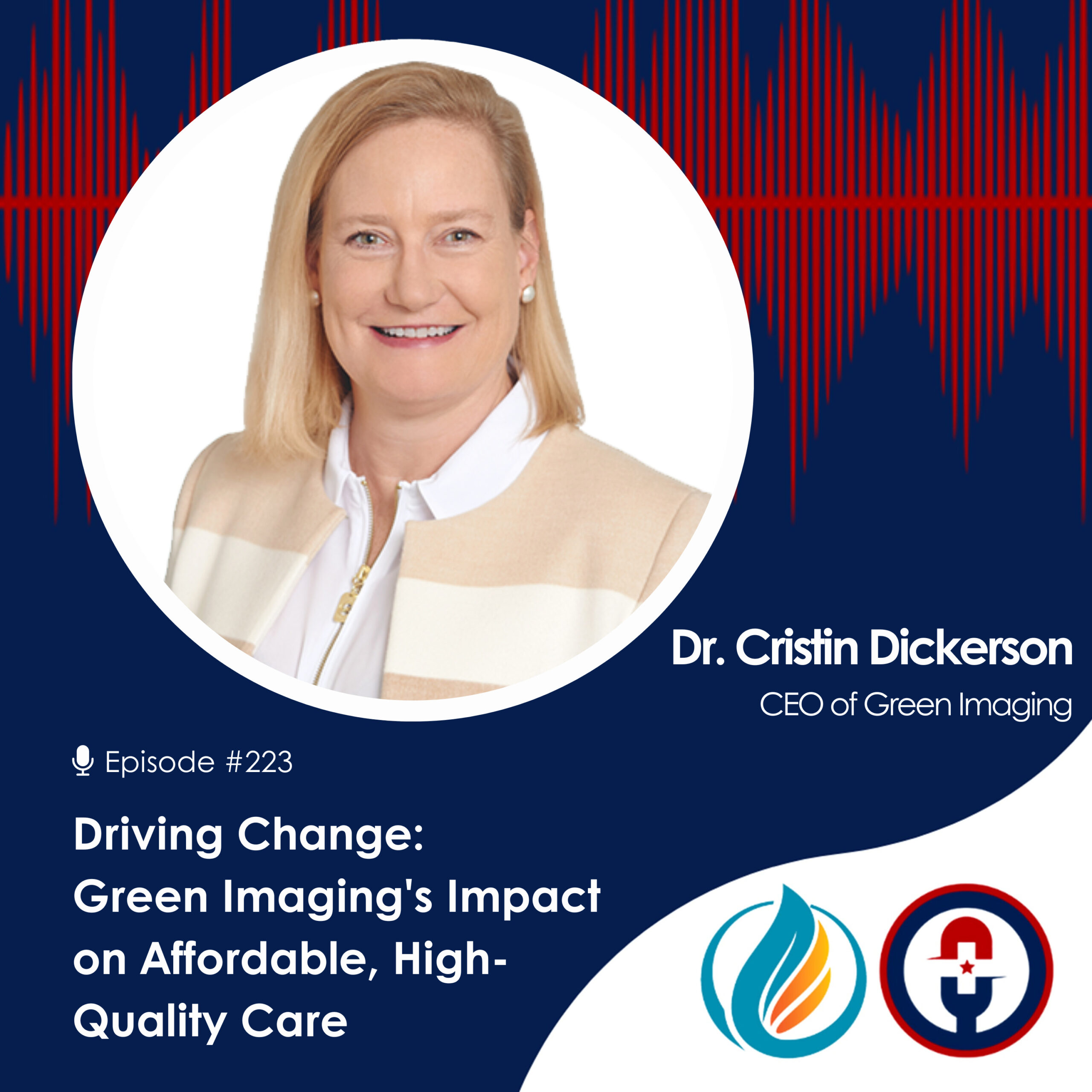
Persevering Through Crisis
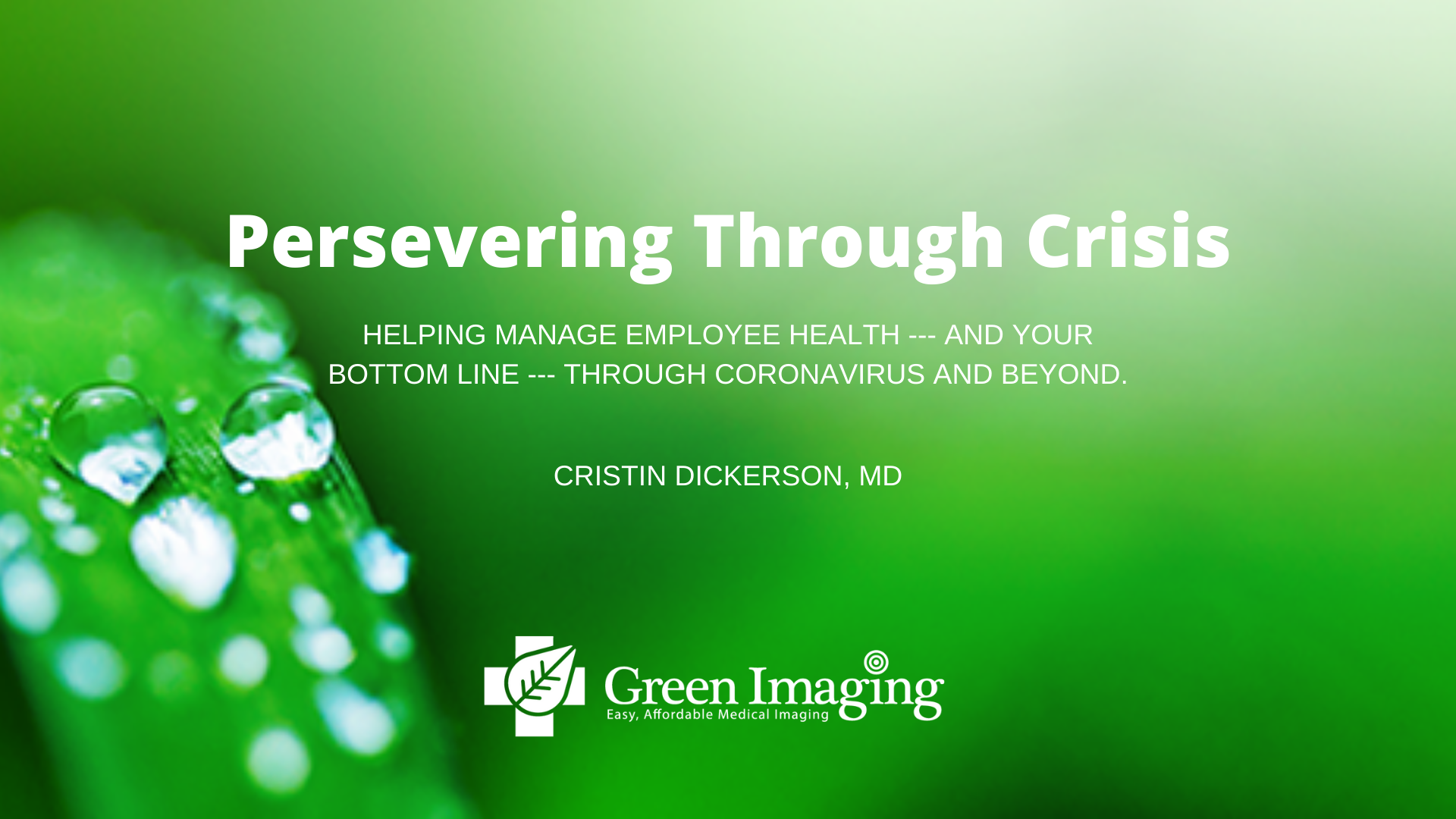
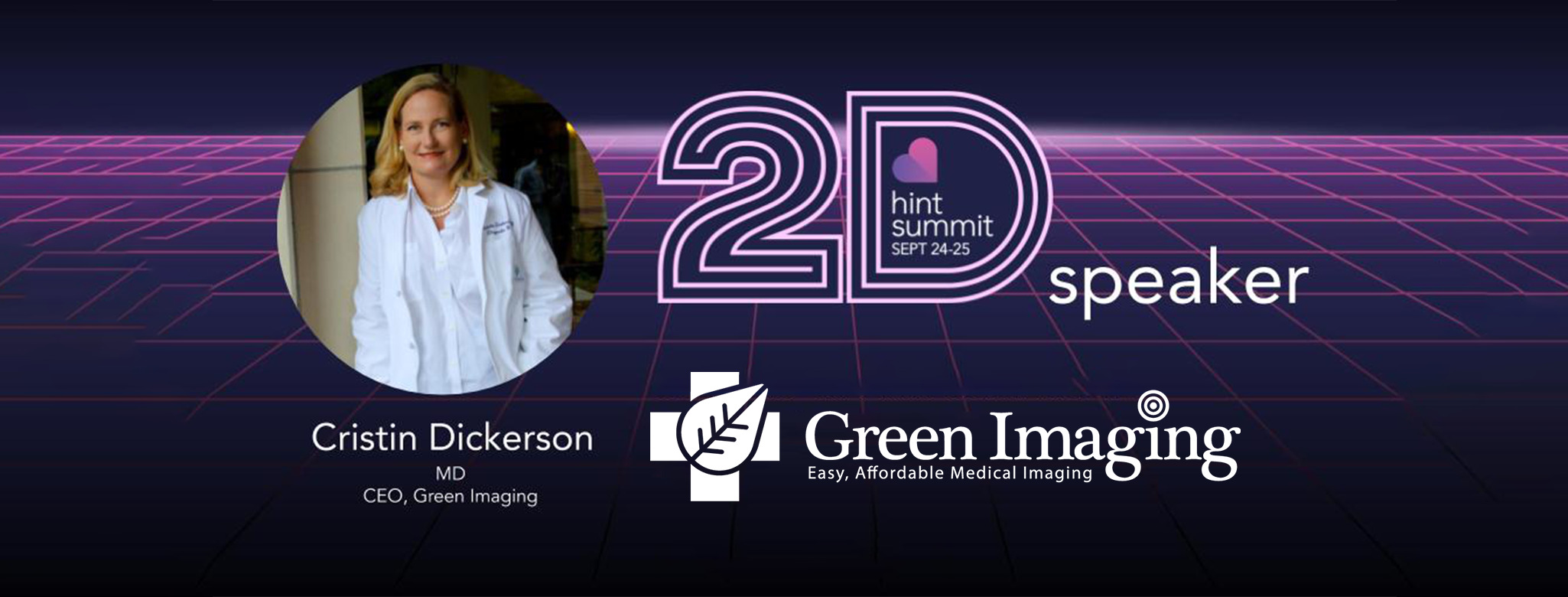
The following content is transcribed from the presentation of Persevering Through Crisis, presented by Dr. Cristin Dickerson. The presentation can be viewed above in its entirety.
There is no question we are in a healthcare crisis and we have been for a long time, but the coronavirus has brought things to a head.
How do we persevere and emerge stronger from a crisis?
I think the silver lining of this horrible period of our life is going to be change in healthcare. I think we've been in a situation where 70% of care was in hospital systems and provided by doctors who are employed by hospital systems, and the cost of care there is three times greater than in the independent world. I think both for safety reasons and cost reasons we're going to be moving to that independent world, and I think it's about time.
My presentation today is in several parts and I'm going to explain what is diagnostic radiology, but also what's essential imaging because that's what we can do right now and should do right now. No question we shouldn't be delaying essential imaging. So I will cover what's involved there, the effect of COVID-19 overall on healthcare and specifically on imaging, direct contracting and how it solves some of these problems, and then hope for the future.
How and what can we do in the future?
How can I help you?
Whether you're contracting with me or the imaging center down the street, how can we make things better for employers and for patients?
What is diagnostic imaging?
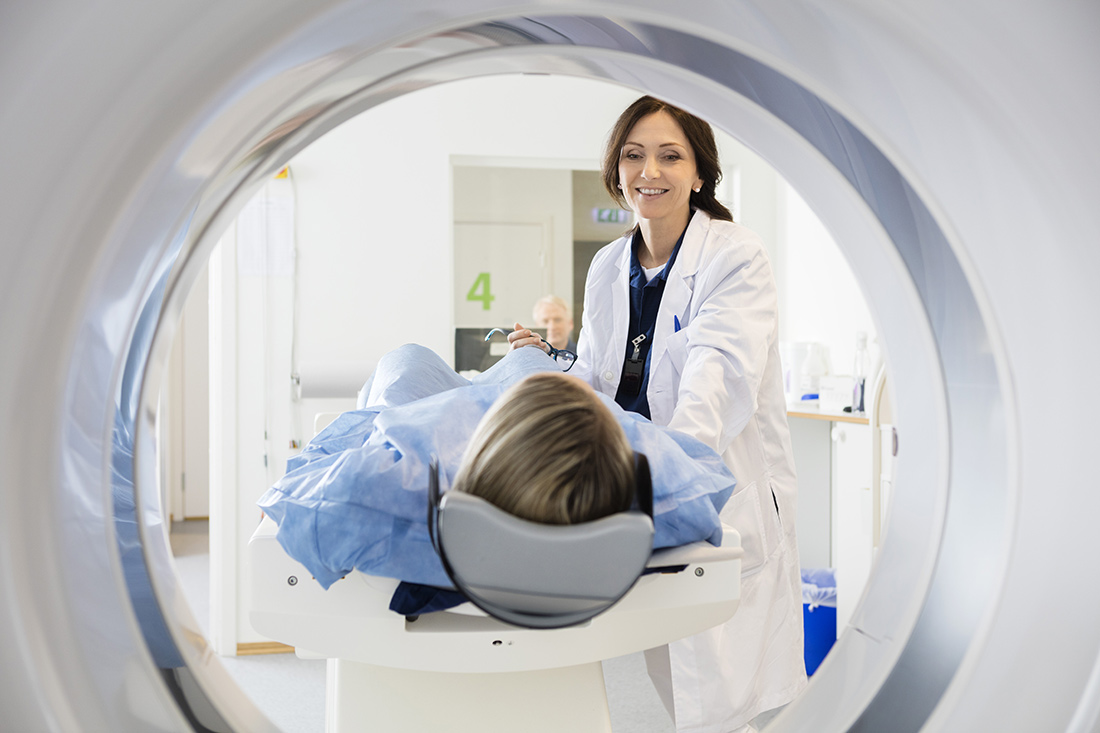
It's X-rays, CT, MRI, PET/CT, nuclear medicine, mammography - it's all those exams that help us both find disease and exclude disease. And the really interesting thing is this care is affordable. It changes the economics of imaging because there is huge value in a negative exam. There's almost no better day of the year than having your mammogram and everything's fine. There's tremendous value. And so traditional healthcare coverage has really tried to keep people away from imaging because it was so expensive and I think we've lost sight of the value. For somebody who's running a marathon and they're having shin splints, the $300, $400, $500 MRI is well worth it to make sure they don't have a stress fracture, the $3,000 MRI, not so much. So diagnostic imaging has value in different ways, both positive and negative.
What happens without diagnostic imaging?
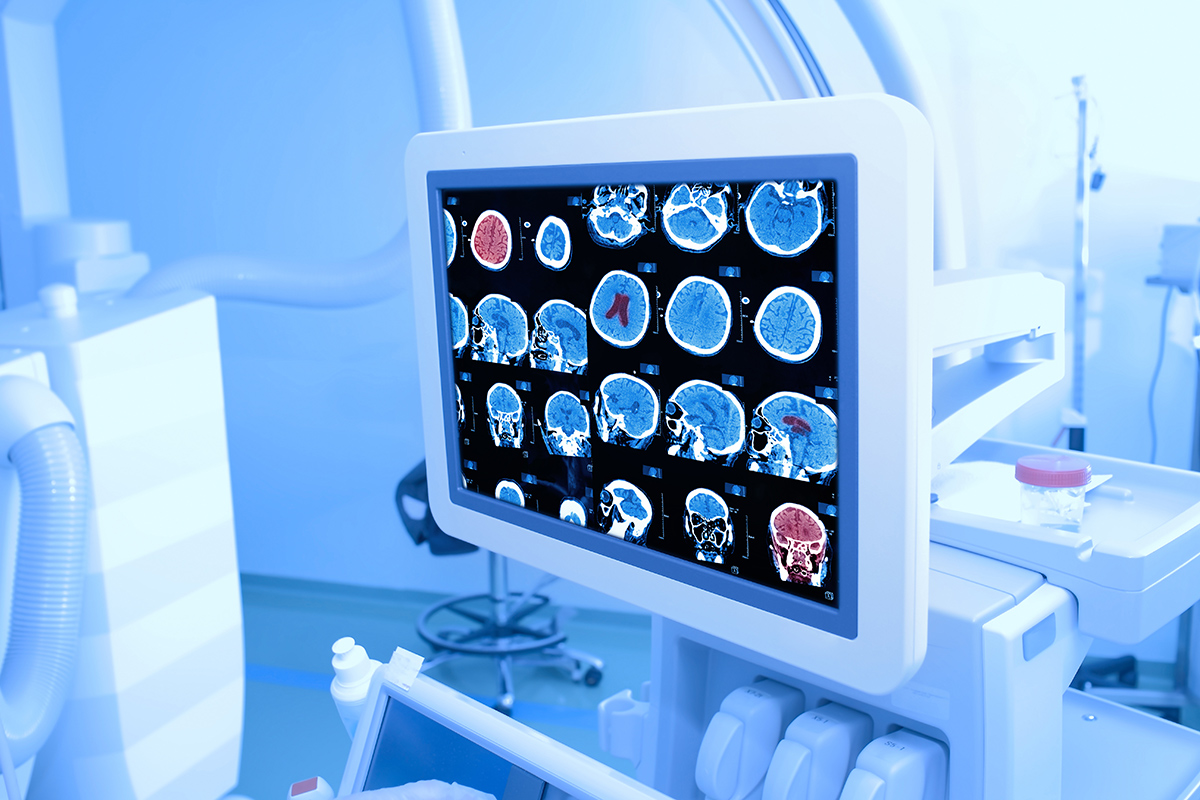
Diagnosis can be delayed, changes in treatment strategies can be delayed. One of the things I know right now is MD Anderson Cancer Center is delaying CT follow-ups until July, which can be critical for cancer patients. Delayed diagnoses may exacerbate the disease. We're going to pick these cancers up at a later stage requiring more intervention. And the cost of treating advanced disease is more expensive for employers.
Essential imaging, I have seen in my practice over the last six weeks, that we're about 50% capacity, about 50% of imaging is essential imaging. So this study was actually published by the American College of Radiology today, that's what people are finding across the country. It is very important that diagnostic exams not be delayed. Diagnostic mammograms are important for a woman with a lump in her breast. That woman should not wait until July to get that evaluated. Acute abdominal pain, chest pain, cardiac chest pain - there are all kinds of exams, suspected appendicitis, all kinds of exams that should not be delayed, they are actually essential imaging.
What we're doing to try to make that work is we're carefully screening at our imaging centers. We're carefully screening for patients who might be symptomatic or might be exposed to coronavirus. So some of that is just the patients signing off on a screening sheet that says that they have none of these symptoms and haven't been exposed or traveled to certain places. Additionally, usually, there's some kind of assessment for fever, some kind of body temperature taking. And then to the degree that protective gear is available, everybody is masking. We are not allowing, in general I don't know of any imaging centers that are allowing extra people, unless somebody needs somebody to help them ambulate, no kids in the waiting room. The waiting rooms are essentially empty. (We are) scheduling patients at wider intervals so that patients are not overlapping. And there's less traffic in the halls. We're doing everything we can to keep these imaging centers safe for patients who need care and might even be immunosuppressed and getting cancer follow-up.
I always say it's a heck of a lot safer than Walmart is right now. So when patients and employees need care, they should not wait on that kind of care. There are going to be a lot of financial effects of this. Right now employers are hurting. If you didn't get that PPP loan, you're laying off, or you're not sure how you're going to keep your payroll going. Employees are hurting and right now there are 50% fewer clients coming in to take care of their health, but those are going to escalate in June, July, and August. Plus, they're going to have these patients who have been hospitalized with COVID and astronomical hospital bills there. So there's going to be huge economic impacts of this.
So it's one thing to just get your employees to a lower-cost provider of care. Another is that cross containment, both for the employer and the employee is going to be huge. If the patient has a high deductible healthcare plan, they're not going to be able to afford care. Before this happened only 50% of Americans had $400 to spend on a healthcare crisis. So I don't know what that's going to be after the COVID -- after the coronavirus subsides.
What can be done?
Well, direct contracting for a lot of things. Employers can save maybe 25%, 30% redoing their pharmaceuticals. Direct primary care can save maybe 20%. Imaging, we can save about 80% on the total healthcare spend, and we're a really easy, first step. Direct primary care is going to be a paradigm shift, changing your formulary, and making sure that you're still taking care of your patients is a several step process. I can get you a direct contract in a week and get you taken care of and get your employees to more affordable imaging solutions really quickly. So it is a really fast thing you can do to get going and start saving these employers money.
Direct contracting for radiology services isn't always screen imaging. We're really convenient because we have a nationwide network and we shop for care in places where we don't have a network solution. But it may, for a small employer, be the imaging center down the street, just your near-site or onsite clinic refers them down the street rather than over to the hospital. Direct contracting for imaging can look a lot of different ways and we're going to talk in a little bit about what you should be looking for when you're doing that direct contracting. Access to care is important, being accessible, not down the hall maybe, but across the street or across town. The patients can be incentivized to drive. I personally have driven from Houston, Texas to Austin, Texas to save several thousand dollars on a 3D MRI for my son. This kind of price differential incentivizes people. There can be shared savings, you can give them gas cards. There are all kinds of creative ways to have employees be receptive to this.
The other thing that's really important is, it's not fun to get an exam in a hospital system. It's not easy. In Houston, you go pay 15 bucks for parking, and then you've got to walk a bazillion miles and find the imaging department. And then they didn't really have you scheduled for today, or there's a three-hour backlog or whatever it is, they got an emergency patient. This can be a real benefit from the hospital ordeal. When you drive up to a freestanding imaging center and park in front of the door almost, in many of them, and walk right in and it's not a crowded waiting room, it can be proved beneficial for employees. And hey also reap the financial benefits as well.
How do I know that's going to be a good imaging center?
And people say, "What about quality? How do I know that's going to be a good imaging center?" I will talk about some of the ways that we look at quality, but there is actually an inverse relationship between the cost of care and quality of care in the United States. There's no direct correlation. You don't get a better 3D MRI if you pay $3,000 than if you pay $500 for it, it just doesn't work that way.
Our imaging network has about 1,143 centers. We actually have come down on our number of centers, where we have redundancy we're pulling out some centers. We're actually very quick to take centers out of our network if we have customer service issues as well.
Cost, of course, is important. It's not the most important reason to do this, but it's a huge reason to do this. And if a value point is not already cost containing on imaging, we can typically save that healthcare plan about 70%. And I'll show you some examples on the imaging spend. If there's already cost-containment in place, like the large company I just talked to that has 650,000 members, has cost-containment, they're already being directed to outpatient centers, we're still able to save them 41% on the imaging spend.
This is a case study, it is a school district in Central Florida, just south of Orlando. And these employees had their entire raise wiped out by the increase in their Cigna premium. And unlike Texas, they had teachers unions in Florida and the union said, "No, no, no, this isn't going to work." And so the school district did two things. Number one, they moved their near-site clinic from a hospital system, that's really great. Three times as expensive, and moved them to the Rosen Health Center. Harris Rosen took his own healthcare plan and got rid of Blue Cross Blue Shield, I think around 18 years ago, and built his own medical center. And he volunteered to take these employees into his medical center when he learned about this problem. And so for $25 copays, all their care is handled at the Rosen Center.
And additionally, they put great imaging in place at zero out of pocket. So getting away from those $3,000 to $4,000 exams, and some of them were even more expensive than that, and getting them to more affordable care. And actually what we've done is, we have our Florida licenses, we're really the radiologists for the school district now and we take care of their patients, and it's great. It's the best part of this model.
Anyway, these were our projections, this is what we thought we could do. We went in and we got their data and we looked at it and we had to rebundle. Cigna had lumped all of the professional fees, the technical fees, the contrast, the radiologists, they had just dumped them into a claims data package. So we had to separate those out, rebundle the imaging, because our imaging is all in - the interpretation, the contrast, everything's all in one flat fee. So we had to rebundle Cigna's prices, and we estimated that their average MRI was about $1,400, average CT was $2,000, ultrasound $330, x-ray $200. And we thought our savings were going to be about in the 70% range. And so we projected a million dollars in savings at 25% engagement, at 50% engagement, 2 million, all the way up to 90%, almost 4 million.
One of the really interesting things that happened when we were looking at this client's data is that we found 600 claims that were coded with hospital revenue codes, not CPT codes. And that, according to Cigna's rules, that's just fine if they're inpatients, but 600 is way too many for those to have all been inpatients in a group this size, 10,000 member group. And so we started picking apart those codes and it was very clear that they were escaping the claims edits. And so MRIs and CTS were being paid out $20,000, $29,000, there was even a CT at $39,000 paid out by the school district.
So that's a whole different story where that's going, but once we got into Florida and we went in and said, "Okay, now..." To our imaging centers, "We have 10,000 lives right here in your town, let's get a better deal for them, these employees deserve it." We've been able to drive down prices, you see here $525 was what we projected as the average MRI, $388 per CT. We actually have been able to get the cost down of those exams. But more importantly, our savings have actually exceeded what we thought we could do in the first quarter. And so in the first quarter we expected we would have been about $250,000 overall in savings. Instead with CT and MRI alone--that doesn't include PET/CT, it doesn't include nuclear medicine, ultrasound, mammography, which is huge for these teachers--we had almost that quarter million in those two modalities alone. So we've been able to exceed our prediction on savings.
Steerage is really important, and I just met with the head of the residence center this morning to talk about how we continue and you'll see a curve in a minute about how we've been able to steer that way, but how do we continue? How do we get to that 90% mark? I think we can, I think these employees are going to be hurting just like everybody else. And I think this is a great opportunity to get to that 90% point.
We have lots of existing resources. All of these tools can be co-branded, whether it's the broker wants to put these out or the employer itself or whoever, these can be co-branded. Step by step instructions on how to use us, these are some postcards that can be sent out. We're actually initiating a Green Imaging newsletter or benefits update that can either be inserted into some of these larger benefits newsletters, or it can be freestanding and just be sent alone to the employees.
And I will talk about, what's the difference between the screening mammogram and a diagnostic? What's the central imaging? How do I know if it's safe to go to an imaging center right now? All of those topics will be addressed there. And I think as we're able to get people interested in answering those questions, they'll become more and more familiar and will be top of mind when they do need that MRI, and they won't go down the hall.
One of the things, this is really the ease of use, this is the thing that's been a game-changer for us. My tagline used to be "the same high-quality medical imaging at a fraction of the price". It now is, "Easy, affordable medical imaging" because this secure HIPAA compliant messaging system has been a game-changer. And so as you can see here with a patient sending three or four texts, and the patient's scheduled, and I think this was in less than an hour that all this occurred. And we were able to go from the patient taking a snapshot of their imaging order, texting us, "I'm a covered member of the school district of Osceola County, my zip code is this and I'd like to have this study on Tuesday." We ask a series of questions, we get them in, they get messaged this voucher. They can confirm their appointment. They can reschedule their appointment through it. We can follow up and find out how their experience with the imaging center was with it. It gives us tremendous power.
And so this has been just one of the game-changers for us. This is what I had been looking for for years. The steerage is very important and we're launching a new enterprise software that will enable us to provide employers with this kind of data where they can see this graph and how we're doing, and if we have a downtick, we can quickly initiate some kind of intervention to get that backup. What we talked about today with the Rosen center was actually going back into the data for the Cigna plan and finding out what providers were continuing to send large numbers of patients to the hospital system rather than to Green Imaging, where the patients would have zero out of pocket.
The employee experience is very important here. We actually, one of the ways that we've been able to provide the steerage is their union. The Facebook page has people extolling the great benefit of having a zero out of pocket and how easy it was to schedule their imaging. The school district's Facebook page, the same. And word of mouth. Mammography is not a moneymaker in imaging. Everybody tries to pull down the cost of mammography so that it's something that people and employers can afford. But I really believe in mammography being a big part of imaging because it gets employees using us, even though a mammogram's a little bit stressful, it gets employees using us in a fairly low-stress situation, which makes them a lot more likely... I can't tell you how often I see on our messaging platform, somebody who's had their mammogram and then they need a CT scan and then they're right back with that same schedule, like, "Hey, I need this now." And so it really makes them much more likely in a stressful healthcare situation to use the plan.
How do we stack up?
Healthcare in general, actually imaging centers, I don't think are at a 4.5 in their review average, but certainly, in healthcare in general, it's 4.5. We're 4.8, and a lot of the times we managed to maintain 5.0.
Most of the negative reviews are not really us, they're, "I had a two-hour wait at the imaging center." And those are things that we actually track to make sure if there are any trends that suddenly we've had three complaints, two complaints even from an imaging center, we're going to go in there and take some corrective measures or actually remove them from the network.
And then the number of reviews we get is five times the industry average, and they're mostly positive, people are much more likely to give a negative review... Or just go take the action of actually doing a review if they're angry. And so, we get lots of positive reviews. And if you look at our reviews, you'll see that most of the time our concierge is called out by name and it's a really important part of what we do is having a compassionate staff to help get people through what's frequently a very stressful episode in their lives.
Once again, the reviews: Quality, we're radiologist-managed, owned, run, operated. There are no unnecessary middlemen here. And so that's how we're able to take some of that cost out of the equation. The most important thing about our being radiologists is it's very difficult... Number one, the American College of Radiology has an accreditation system that has really done a pretty good job of assuring quality across imaging centers. But that's a point, one of the things about ACR accreditation, you do it every three years and a lot of centers hire an expert to come in and help them through this. It doesn't really measure the day to day quality of an imaging center. It's a point in time every three years, and it certainly doesn't look at customer service. It doesn't look at radiology reports. It doesn't look in a lot of the factors. So a lot of things are difficult to quantify in radiology.
The Technologist skill is huge, ultrasound and mammography are probably equally as important, the technologist skill as MRI and CT and PET/CT. Patient motion, and it's also the technologist's ability to reassure the patient, they keep it low stress so the patient's not moving in pain. The more that they can make the patient comfortable, the better the image quality is going to be.
If you're looking at using an imaging center, the things you look at are, I would want to know who the technologists are, what's their experience level. Pride in their staff, good companies have to take great pride in their staff. My big red flag is when they don't have the radiologist's pictures and credentials up on their website, I wouldn't use that imaging center. Website should demonstrate range of subspecialties, pride in their radiologists. It shouldn't be only chiropractic radiologists, chiropractic radiologists are fine for chiropractic referrals, but the chiropractic radiologist is trained to look at certain things, not all of the organs that are in that image. And so certainly you want MD radiologists. If I'm reviewing a center I want to look at the reports, we actually have the ability to embed images into our reports so that the orthopedist doesn't have to go track down a CD to see the fracture, we can actually show a key image that shows that fracture.
If imaging centers won't allow us peer review, that's a negative. I'm not going to do that. I'm not going to take that. So, even if you're contracting with an imaging center down the street, you might want to get some kind of ability to provide some outside peer review to make sure that the quality is good. The ability of referring doctors to contact the radiologists, ask questions, they can text us on our system, they can securely message us and ask a question or ask for a comparison or ask what the next best step is. Good tools, the tools for reminding the patients of appointments. Tools for scheduling easily, for electronically filling out those forms so you're not sitting there in the imaging center doing that, especially right now, you want to minimize your time in the center. All of those things are more important than brand new equipment and standardized accreditation.
Brand new equipment, I just looked at GE's pamphlet for their 3T MRI, there is nothing about better image quality than your existing MRI scanner. It's all about faster throughput. There's actually nothing proven that they can put in there that says the image quality is better. So take that with a grain of salt because it's a 1.5 Tesla magnet manufactured in the last 25 years is the bread and butter of imaging. Certainly, some exams are better done on a 3T, probably prostate imaging, maybe endometriosis evaluations, some orthopedists will say cartilage, but all of these orthopedists who have their own MRIs and they have 1.5 Tesla magnet, I don't know of one that has purchased a 3T, I'm sure it's not half, but the bread and butter is still the 1.5 Tesla magnet.
How can this work? I want to sign up, how can I do this with Green Imaging? It's a bolt-on plan and it's actually best initiated, not at re-enrollment because if you bolted on mid-year employees, see, "Wow, I get imaging at zero out of pocket." They take it as a real benefit, not just something else to hassle with at re-enrollment, some other way that I'm going to get my healthcare benefits limited. They really appreciate having it separated out from re-enrollment.
The process can be very quick if you want us to do some claims analysis that can delay things, but I've had employers enrolled in three days, that's not a problem. Again, I, as a radiologist and I, as somebody who owns an MRI center, this isn't the old days of one call and you ask radiology. We're paying the centers fairly. We have a transparent markup as a 20% markup that we charged to provide the concierge service and our vetting and our contracting and all of the software and technology that we use to make it easy for patients. We pay our imaging centers well, and they appreciate that, and our patients get treated well. Somebody asked me today about benefits cards, and we used to give out a Green Imaging benefits card. We no longer do that. We asked that at re-enrollment, we'd be put on the healthcare card, as imaging provider with our phone number and our access. Or we can do a color forms like stick on to the existing card, if it's mid-year.
Again, I think this is a tremendous opportunity to start shifting healthcare out of the hospitals and back into the more affordable, independent care situation. It's a great time to get the unneeded middleman out of health care. Plan design is very important, and we did learn that we had to actually approve plan design because we had somebody who actually put a $375 copay in place in front of brain imaging, that doesn't work. Most of the exams cost less than $375. So even though the employees would say money with us, they didn't see it as an incentive. And so there are things like that that are very important.
What do brokers and HR people and CFOs need to do to change, make this paradigm shift? They need to demand transparency. They need to exercise their fiduciary responsibility and that's even more critical now. They need to do a great plan design that really stops looking at just this benefit year and starts looking at the longterm health of that workplace. They need to provide communication and education, and they need to get rid of things that are barriers to necessary care. I don't know anybody who takes off from work and goes and lies in a cold loud tube, and has stuff injected into a vein for fun, it just doesn't happen. And we don't see changes in utilization once this benefit becomes available. In fact, because of people's tight pocketbooks people have been delaying here. And so I think this is just a better way to get care early so that things don't cost as much in the long run both from a health standpoint and a financial standpoint.
When we do wellness, everybody wins, employer, doctors, because doctors can become independent again, and employees/patients. We have been recognized, we actually won the Health Value award at the World Healthcare Congress that was electronic this year, that was a little bit of a letdown. But we won the gold medal for specialty imaging and we've been receiving awards, you can see for the last few years.
This is just a really quick one, 10 reasons not to work with us. You want to get your employees to go into debt because of the cost of their MRI at the hospital. You find it humorous when your employee gets a surprise bill from the radiology group after they've already paid $3,000 for an MRI. You enjoy paying $20,000 dollar claims for incorrectly coded MRIs and CTS. You feel trying to make sense of incomplete claims data to make health plan decisions is a worthwhile challenge. You feel it builds character when your traditional plan offers screening amendment grants at no cost and requires the woman with a lump in her breast to pay out of pocket. You believe there's a positive correlation between quality and cost and healthcare. You think employees writhing in pain as they wait for an authorization for an MRI adds to workplace productivity. You believe hospitals want pricing transparency and will make it easy for patients and employers to shop for care. You like paying 75% more than necessary for the same imaging. And you have no desire to save 80% or more, eventually millions of dollars, on your total healthcare spend. This is how to reach me, and I have enjoyed speaking with you.


DR. CRISTIN DICKERSON, MD















